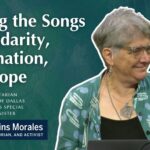Sacred Geography: Space | Rev. Beth Dana | 03.03.24

As we continue our series on “Sacred Geography” we explore where and how we recognize sacred space, and in what ways we can be creators of it.

Sermon Transcript
“I need space.” These are the words you never want to hear from someone you love, but truly, every person needs space in which to live and grow and thrive, and love, as much as plants need air to grow and logs need space in between for the fire to burn. Perhaps some of you learned about dancing while leaving space for the Holy Spirit. Anyone? Yeah, see a couple of hands. My children, as you heard in the story, learned in pre-K and kindergarten about their personal space bubble and how to respect their own and others’ space without popping the space bubble. It’s part of learning basic social skills because it’s an important part of how we relate to each other and to the Holy. Space was a big theme in my life coming out of the pandemic, as I imagine it was for many of you during a time when many felt isolated, a time when some relished the space in their days brought about by the change of pace and reduced demands, and a time when we were mandated to keep our physical distance from one another.
Ironically, I felt smothered, stuck at home, deprived of real people, contact beyond my family with the demands of life, actually more in my space and my face than they were when life was busier but more balanced. When I started working from my office at the church again, I decided that I needed to make the space more my own. I took down a framed Mondrian-style print that had hung there for the tenure of multiple staff members before me. Its origin unknown. I do love Piet Mondrian, but it wasn’t the vibe I was going for in my office. And so, I resolved to live with a big blank wall until I figured out what needed to be there, how I could make the space reflect who I am and what’s important to me. And then it came to me. How can I bring sacred spaces I’ve known into this office space? My ministry home base.
So I gathered about 15 images, some photos and some paintings, of spaces that have been sacred spaces that I’ve experienced over my lifetime. Some are traditional sacred spaces or houses of worship. Some are images connected to family in some way, and some are outdoors in nature. I ordered five by seven prints and framed them, and bought those little 3M picture hangers so as not to fill the wall with nail holes. And nearly two years later, these items remain on my desk, still waiting to be hung. Ridiculous, right?
I failed to make the space and time in my schedule to arrange and hang them. My office wall is still a big blank space waiting to be filled with so much beauty, and I tell all of this to you today so that you can help hold me accountable. I hereby promise to hang this Sacred Space Gallery before the end of spring break. Who will hold me to that promise? Oh, yay, lots of hands. Thank you. Thank you. You can come check in my office, as some people in the first service said that they were going to.
Exploring Sacred Spaces
The rest in between musical notes, as we heard so beautifully in the interlude, is when the beauty of the music sinks in and we catch our breath. The silence between words is when we can listen to the still small voice and when new words and ideas, and insights emerge. The space between logs is what makes the fire burn. The space in between the spokes of a wheel inside a vessel and the rooms of a house are what make them useful. As Lao Tzu wrote, “The substance of your body is enlivened by maintaining the part of you that is unoccupied.” In this Sacred Geography worship series that we are in, we are exploring different dimensions of our spiritual landscape or the ways that the sacred shows up in everyday spaces and in our everyday lives. This week we are exploring the landscape of sacred space. So often, we talk about sacred space as a physical space that we are in. The sanctuary is a sacred space, or we create sacred space in small group meetings by lighting a chalice and breathing together, or we experience sacred space in nature. The Latin root of the word sacred means set apart.
“Roadside Religion”
Scholars of religion have written volumes and volumes about the meaning of sacred, typically describing it as something set apart or wholly, radically other. One of these scholars, Timothy Beal, a professor of religion at Case Western Reserve University, did an experiment in the summer of 2022 when he loaded his family into a motor home and traveled across America in search of roadside religious attractions, things like the world’s largest 10 commandments, holy land, USA, Biblical mini golf, and Noah’s Ark of Safety. His book, Roadside Religion, chronicles his travels and reflects on the meaning of these places. He wrote, “The sacred is where you encounter God, the Holy, where you feel awe, where things have a flash of making sense to you, where you have a feeling of connection to that which is larger than yourself, where you suddenly have new information that makes a shift inside you, and things are different now.”
And he asks, “When you have that feeling, is it inside of you or is it in the place itself? Are there real sacred places, springs, and mountains coming together of lay lines or a vortex of energy? Or are there just places that have been invested with meaning by the people who carried within themselves a human urge to be part of something larger than themselves?” Beal is questioning the notion that sacred space is wholly other and challenging us to consider, is sacred space separate from us, or is it inside of us, or even at times enveloping us? My answer would be all of the above. It permeates the sacred landscape that we traverse and can be found, created, and held without us being transported to a separate realm.
Sacredness in Betweenness
Sandy Eisenberg Sasso, the author of many wonderful books for children and adults, tells a story about this. The story takes place in a town at the foot of a hill where there are no roads and no windows. It sure sounds like another realm, doesn’t it? But listen to what happens. Without roads, the people had nowhere to go, and they wondered what was on the other side of that big hill. Whenever they left their homes, they sneezed through tall, tangled weeds and tumbled into deep holes, and tripped over rocks as large as watermelons. Without windows, they slept, laid into the day, and wondered about the rhythms of the sunset and the sunrise. They never looked out of their homes, and their neighbors never looked in. One day, the people got fed up with this way of living and gathered in the center of town to decide what to do. Someone said, “I’ve heard there’s a God and that God solves problems.” And so someone shouted, “Let’s find that God.”
So there were two little houses on the edge of town, each with one window, and in these houses lived the ones who could see out windows. The people reasoned that if they could see out windows, perhaps they could see a way to God, who would solve their problems. The ones who could see out windows at the request of the townspeople each set out on their own. One went to the other side of the hill and up a tall mountain but didn’t see God. They set sail far out into the ocean, but they didn’t see God there. They traveled to the desert but didn’t see God, and they went deep into the cool quiet of a cave but didn’t see God there either. And after all these travels, they were tired, so they decided to stop looking for God and returned home. When they saw each other, they saw how disappointed and defeated the other was and knew that neither had found God, but they sat with each other and told stories about their travels, and in the dark night they could only see each other.
As the sun dawned, they decided to head back to their houses, and along the way they encountered some of the townspeople, and the people shouted, “Tell us, where is God?” And when the ones who could see out windows told about their travels and their failure to see God in those places, the people very disappointed said, “We were right all along, there is no God.” While the days went on and the people continued complaining about their situation, the ones who could see out windows helped each other, put windows in every room of their homes, they cut the tall weeds and filled in the deep holes, and cleared the rocks to build a road in between their houses. When the townspeople finally stopped complaining and noticed what had happened, they were stunned. They’d never built roads, and they had never seen so many windows. “How did you do that?” they asked, and the ones who could see out windows answered, “With God’s help.”
Now, the people were very confused. They thought there was no God, but the ones who could see out windows explained, we journeyed hundreds of miles looking for God, and then we found each other and we discovered that God was with us. “With you?” said the townspeople. “Yes, with us.” “Right here at home?” “Wherever we are,” they said. “But I can’t see God anywhere. All I see is you. If God is here, show us,” said the townspeople. So the ones who could see out windows got close to them and responded in a hushed voice, “God is in the between, in the between. In between us.” Now, like the townspeople. We human beings live in a scientifically advanced world and want to see and understand things to know that they are real. And yet, despite our efforts and all that we know, some things are beyond our capacity to fully grasp.
The Unseen and the Sacred
God remains a question even for the most thoughtful theologians. Dark matter and dark energy allude even the most expert scientists, dark matter makes up about 27% of the cosmos and dark energy, about 68% of the universe. Dark matter takes up space, but we can’t see it. And dark energy is known only because of its role in the accelerating expansion of the universe. Dark matter doesn’t reflect, absorb, or radiate light, at least none that we can detect. But scientists understand it as a web-like structure that winds through the universe with gravitational forces that attract and hold the matter that is visible.
Scientists are still seeking to fully understand dark matter and dark energy, but what they do know is that there exists something between us and around the things that we can see that has a profound impact on us and is an essential component of our universe. It’s like the air that fuels the fire, the silence that allows for the next insights to emerge, the space that deepens our spiritual life and infuses the sacred in every day.
Creating Space for the Sacred
When we engage in spiritual practices, we are creating space for the sacred. We are setting aside, set apart. Set aside time for meaning to emerge from the fullness of life. As we explored in the worship series earlier this year, activating your spiritual life, spiritual practice can be quite simple. And while it must be intentional, it does not require extraordinary or radically other activities or circumstances. In his poem, Any Morning, William Stafford writes, “Just lying on the couch and being happy. Only humming a little, the quiet sound in the head. Trouble is busy elsewhere at the moment, it has so much to do in the world. People who might judge are mostly asleep, they can’t monitor you all the time, and sometimes they forget. When dawn flows over the hedge, you can get up and act busy. Little corners like this, pieces of heaven left lying around, can be picked up and saved. People won’t even see that you have them, they are so light and easy to hide. Later in the day, you can act lidke the others. You can shake your head. You can frown.”
I love this image of picking up and saving little pieces of heaven, so light and easy to hide that help you to face a world that is too often frowning and judging, and troubled. I wonder what space, both time and place do you have in your life when you gather up these pieces to carry with you and to sustain you.
Sacred Spaces in Times of Crisis
Building heaven on earth is one of the ways that we unitarian universalists live our faith, and our materials are sourced from many different places. Now, it’s easier to do this when life is relatively easy and carefree, when the troubles of the world don’t touch us directly, when we are free of threats of violence or oppression, but that is not everyone’s lived reality. Space is precious and sacred, and life-giving, so encroaching on space is a power move. A move that oppressors and aggressors have been using since the beginning of civilization to dehumanize their enemies.
Think about many different acts of violence against people, communities, nations. They often involve annexing space, crowding, packing people in as if they’re sardines and not human beings. These tactics have been used over and over again throughout history and are at work today. So what does the spiritual landscape of space look like for people who are being crushed by the powers that be? It often looks like finding space within or using what resources you have to achieve what’s been called spatial agency. It’s an act of resistance and resilience to find spiritual space in an environment in which physical space is seriously constricted. During World War II, Anne Frank lived for two years in a secret annex of a home in Amsterdam with her family and one other, hiding from the Nazis. Although their living space was cramped and the only experience of the outdoors that she had for two years was gazing up at the sky from the window, her father gave her the gift of space when he gave her a diary in which to write.
She wrote in this diary, “The nicest part is being able to write down all my thoughts and feelings, otherwise, I would absolutely suffocate.” The blank page gave her space to express herself, to grow, to develop her personality and her playfulness, and ultimately to share her wisdom with all of us who have read her diary since it was published. Anne’s family was in hiding, as I mentioned, with one other family, the Van Daans, and to their son Peter, she said, “We’ve been missing out on so much here, so very much, and for such a long time. I miss it as much as you do. I’m not talking about external things, since we’re well provided for in that sense, I mean the internal things. Like you, I long for freedom and fresh air, but I think we’ve been amply compensated for their loss. On the inside, I mean. This morning, when I was sitting in front of the window and taking a long, deep look outside at God and nature, I was happy, just plain happy.”
So in the space of her heart, Anne was able to hold onto little pieces of heaven in a climate that was full of fear and hate. And of course, I also think of Palestinians today who’ve been crammed into a small stretch of land, their lives, and the places infrastructure completely decimated and cut off from resources. There’s little room to breathe, little food to eat, and while I am sure that more stories will emerge as time goes on, I wonder about their inner lives, particularly of the children living there. Children like Anne. How are they reclaiming space? How’s their faith helping them resist? What are their sources of happiness? Are there spaces where they do feel safe? In what ways are they resisting oppression and claiming their spatial agency? Are they finding little pieces of heaven and hiding it in their pockets to sustain them through the hell that they live in currently? I don’t know the answers to these questions, but I hope someday that we will.
The Role of Community in Sacred Spaces
Sacred space, space in which we can encounter God, the Holy, experience awe, make meaning, and feel connected to something larger, exists everywhere, whether we can see it or not. It’s not only in houses of worship like this. It’s in your home, with or without windows. It’s in nature on mountains and deserts and caves, and deep seas. It’s in land without roads and in densely developed places with crisscrossing networks of roads. It’s in your imagination and in your heart. It’s not wholly other. It’s wholly here. In church, we sometimes talk about holding space. We can hold space for others, for feelings, for all that’s happening below the surface in the spaces between and in the silence that we can’t see or hear, but we can sense and the impact of which we know deeply.
Can you think of a time when someone held space for you? And I see a couple nods. I can. They were centered. They didn’t speak much. They were very attuned to me and to the space that we were in. They went with me rather than trying to lead the way. Their presence helped me to find something within myself, something that I may not have recognized otherwise. This is how we take the sacred space that we experience in certain places, like this church, out into our lives and into our world. By finding, creating, and holding sacred space and allowing for openings in which the flame that knows how it wants to burn can find its way, every one of us can do this.
We can do it for our spouse or partner, for our children, for our friends. We can do it in worship by being present and knowing that, while some words and music may not resonate deeply with me, they do for someone else. We can do this in small groups when we listen to one another. We can do this in pastoral visits or conversations, holding space for joy and sorrow and everything in between. We can do this when we gather in classes, holding space for everyone to learn and to share their wisdom. We can do this in tense or difficult situations, not trying to fill the silence but holding space for thoughts and feelings to be shared and received.
We can do this by being allies to those who are most impacted by forces of oppression and injustice. We can do this by building roads and windows and modeling community building. We can do this by giving someone a journal full of blank pages in which they can reflect and grow. You get the idea? We are traveling this journey of life together, and there are so many opportunities to find space, create space, and hold space for ourselves and for others along the way. So let us bless the space between us by practicing this in the days ahead. May it be so, and amen.







